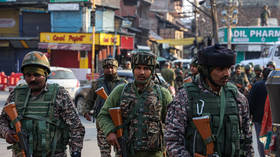Up to 250 people killed in alleged chemical attacks in Darfur since January – Amnesty (GRAPHIC)

Up to 250 people, many of them children, have died from exposure to suspected chemical weapons in Darfur in the past eight months, Amnesty International has reported. The Sudanese government has denied chemical weapons use.
The alleged chemical weapons attacks took place in each of the four areas in the Jebel Marra area in Darfur that experienced major violence in 2016, Amnesty wrote in its report.
“The scale and brutality of these attacks is hard to put into words,” Tirana Hassan, Amnesty’s director of crisis research, said in a press release on Thursday, reiterating that the use of chemical weapons is a war crime.
According to the human rights group, at least 30 “likely chemical attacks” have taken place in the Jebel Marra area of Darfur since January 2016. The latest of them occurred on September 9, Amnesty says.

Amnesty’s investigation was based on satellite imagery, over 200 interviews with survivors, and expert analysis of images showing injuries.
“The images and videos we have seen in the course of our research are truly shocking; in one, a young child is screaming with pain before dying. Many photos show young children covered in lesions and blisters. Some were unable to breathe and [were] vomiting blood.
“It is hard to exaggerate just how cruel the effects of these chemicals are when they come into contact with the human body. Chemical weapons have been banned for decades in recognition of the fact that the level of suffering they cause can never be justified. That Sudan’s government is now repeatedly using them against their own people simply cannot be ignored and demands action,” Hassan said.
One young woman interviewed by Amnesty said she was injured by shrapnel when a bomb that emitted a toxic cloud of smoke fell on her village. She says she and her baby have been sick for the last six months.
“When [the bomb] landed there were some flames and then dark smoke,” she said. “Immediately it caused vomiting and dizzying… My skin is not normal. I still have headaches, even after I took the medicine… The baby is not recovering… he is swollen… he has blisters and wounds… they said he would get better… but it is not working.”
Another woman said she was at home with her children in the village of Burro when it came under attack. She told the human rights group she saw bombs discharging black smoke.
“Several bombs fell around the village and in the hills… Most of my kids are sick from the smoke of the bombardment… They got sick on the day of the attack… They vomited and they had diarrhea… They were coughing a lot… Their skin turned dark like it was burned.”
A number of the victims told Amnesty they had no access whatsoever to medicine, and were being treated with a mixture of salt, lime and herbs.
One man, who helped to care for people he believed had been exposed to chemicals, said some 19 civilians he cared for passed away within a month of exposure, children among them.
The suspected chemical weapons agents were allegedly delivered by rockets and bombs dropped from planes. Amnesty said it presented its findings to two independent chemical weapons experts, both of whom concluded the “clinical signs and symptoms were most consistent with exposure to a class of chemical warfare agents called vesicants or blister agents, which include lewisite, sulphur mustard and nitrogen mustard. However, they also asserted that it was possible that survivors were exposed to a combination of chemicals in addition to blister agents.”
“This is first documented, substantial evidence of chemical weapons use inside the Darfur region,” report author Jonathan Loeb told the Independent. “These bombs and rockets unequivocally came from Sudanese government forces, that we know beyond doubt. There are no other armed actors in the area with any air force [capable of these attacks].”
At least 300,000 people have been killed in Darfur since the conflict between rebels, government forces and allied militia broke out in 2003, according to figures released by the UN in 2011.
The alleged chemical attacks come amid a major military offensive launched by Sudanese forces in January this year against the Sudan Liberation Army, which they blame for ambushing military convoys and attacking civilians.
In response to Amnesty International’s accusations, the Sudanese government said it does not possess any type of chemical weapons, calling the human rights group’s report "utterly unfounded." Sudan joined the Chemical Weapons Convention (CWC) in 1999.
"The allegations of use of chemical weapons by Sudanese Armed Forces is baseless and fabricated," Sudan's UN Ambassador Omer Dahab Fadl Mohamed said in a statement, as quoted by Reuters. “The ultimate objective of such wild accusation, is to steer confusion in the on-going processes aimed at deepening peace and stability and enhancing economic development and social cohesion in Sudan."















